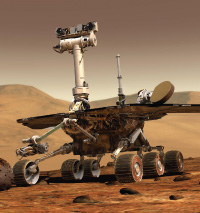Men to Mars Possible in 60’s, Experts Say
Read the full article (PDF) | Vote on future topic | Search archives
January 16, 1960 | Vol. 77 | No. 3
Men to Mars Possible in 60’s, Experts Say
THE UNITED STATES will be able to send three men on a 14-month expedition to Mars in a nuclear-powered two-stage rocket ship during the 1960’s, three space experts assert.
The rocket ship would go into orbit around Mars, and the exploring party would use a chemically propelled “taxi” to go down for a close look at the Martian landscape. After exploring for two months, the party would refuel their orbiting space ship and head back to earth.
Tanks of hydrogen, for refueling purposes, would be launched about a month earlier than the manned ship to make certain they are on course and that the hydrogen will be available on Mars. These tanks, taking a slower, easier path, would arrive at Mars after the manned ship. Three tankers each carrying 88,000 pounds of propellant could provide enough fuel for the return flight.
UPDATE | July 30, 2011
Kennedy was a moon guy, Obama prefers Mars
 The Mars rovers Spirit and Opportunity (artist’s conception) landed on the Red Planet in 2004.
The Mars rovers Spirit and Opportunity (artist’s conception) landed on the Red Planet in 2004.
Like chocolate or vanilla, white or wheat, boxers or briefs, the choice between sending astronauts to explore the landscape of the moon versus that of Mars has joined the list of life’s deepest debates
Though at first the notion that people could have walked on the Red Planet by the end of the 1960s seems silly, when the historical context is considered, it’s not so hard to imagine how a manned mission to Mars seemed attainable.
Enthusiasm about space during the ’50s may be second only to the excitement of the ’60s. Improvements in rocket technology made it possible to send more weight farther. And Sputnik got Americans thinking about how they could claim their place in space.
When NASA was established in 1958, lunar and planetary exploration were on the top of the agenda. But the moon took the lead when President John F. Kennedy in 1961 famously said, “I believe that this nation should commit itself to achieving the goal, before this decade is out, of landing a man on the moon and returning him safely to the Earth.” Though the planets were on the minds of many, political priorities were clear.
Since then, a number of people proxies have landed on Mars: Viking 1 and 2, Pathfinder, Spirit, Opportunity, Phoenix. But the boots of an astronaut have not yet touched down. Beyond the additional technologies required for a manned mission, scientists have to consider the physical and psychological effects of a year-plus trip.
But Mars may finally get its turn. Last year President Obama announced that the United States would abandon plans for another visit to the moon and instead focus on Mars. Such a mission is not expected to launch for at least another 20 years. —Elizabeth Quill
Credit: Rover: JPL-caltech, NASA, Cornell Univ.